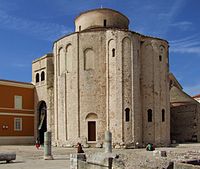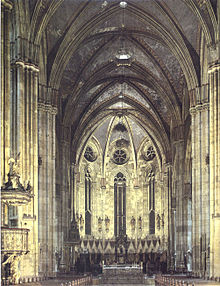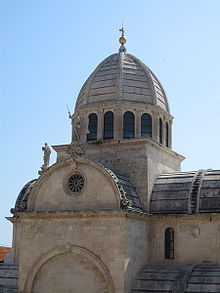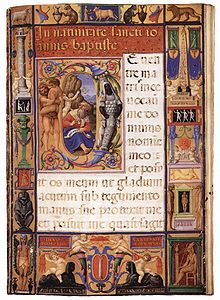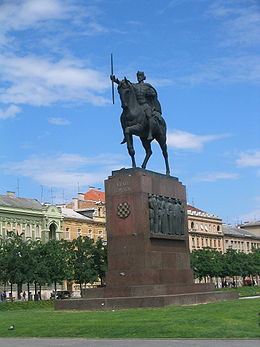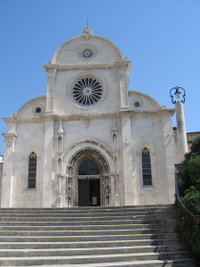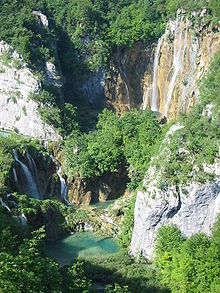- Culture of Croatia
-
The culture of Croatia has roots in a long history: the Croatian people have been inhabiting the area for fourteen centuries, but there are important remnants of the earlier periods still preserved in the country.
Part of a series on the Culture of Croatia 
Timeline History of Croatia Medieval Kingdom Renaissance National Revival Culture and Traditions Alka · Cuisine · Dance · Dress · Easter egg · Language · Tamburica · Tattoos · Wine Arts Art · Architecture · Cinema · Literature · Music Religion Religion · Christmas Eve · Our Lady of Sinj · Marija Bistrica · Our Lady of Međugorje · Saint Joseph · St. Mark's Church · Old Church Slavonic Society Education · Nature parks · Matica hrvatska · Sport · Radio · Television · World Heritage Sites Symbols Flag · Coat of Arms · Anthem · Licitar · Wattle
Croatia Portal
Contents
Ancient Heritage
Ancient monuments from the Paleolithic era consist of simple stone and bone objects. Some of the earliest remaining historical features include 100,000 year old bones of a Neandertal man near Krapina (Krapina-Zagorje county).
The most interesting Copper Age or Eneolithic finds are from Vučedol culture. Out of that culture sprung out Bronze Age Vinkovci culture (named after city of Vinkovci) that is recognizable by bronze fibulas that were replacing objects like needles and buttons. Bronze Age culture of Illyrians, ethnic group with distinct culture and art form started to organize itself in 7th century BC. Numerous monumental sculptures are preserved, as well as walls of citadel Nezakcij near Pula, one of numerous Istrian cities from Iron Age.
Greeks from Syracuse in Sicily in 390 BC came to islands of Vis (Issa), Hvar (Pharos) and Korčula (Corcyra Nigra) and there have founded city-states in which they lived quite isolated.
While the Greek colonies were flourishing on the island, on the continent the Illyrians were organizing their centers. Their art was greatly influenced by Greek art, and they have even copied some. Illyrians even conquered Greek colonies on Dalmatian islands. Famous was the queen Teuta of Issa (today island of Vis) which waged wars with the Romans. But finally, Rome subdued the Illyrians in first century, cesar and after that the history of these parts is a history of Illyrian provinces of Rome and Byzantium.
The Romans[1] organized the entire coastal territory by transforming citadels to urban cities. There have been at least thirty cities in Istria, Liburnia and Dalmatia with Roman citizenship (civitas). The best-preserved networks of Roman streets (decumanus/cardo) are those in Epetion (Poreč) and Jader (Zadar). The best preserved Roman monuments are in Pola (Pula) including an Amphitheater (an arena) from the 2nd century.
In the 3rd century AD the city of Salona was the largest (with 40,000 inhabitants) and most important city of Dalmatia. Near the city emperor Diocletian, born in Salona, built the Diocletian's Palace (around year 300 AD),[2] which is largest and most important monument of late antique architecture in the World. In the 4th century Salona became the center of Christianity for entire western Balkans. It hade numerous basilicas and necropolises, and even two saints: Domnius (Duje) and Anastasius (Staš).
One of few preserved basilicas in western Europe (beside ones in Ravenna) from the time of early Byzantium is Euphrasian Basilica in Poreč from 6th century.
The early Middle Ages brought the great migration of the Slavs and this period was perhaps a Dark Age in the cultural sense until the successful formation of the Slavic states which coexisted with Italic cities that remained on the coast, each of them were modelled like Venice.
Croatian art
In the 7th century the Croats, along with other Slavs and Avars, came from Northern Europe to the region where they live today.[3] The Croatians were open to Roman art and culture, and most of all to Christianity. The first churches[4] were built as royal sanctuaries, and the influences of Roman art were strongest in Dalmatia where urbanization was most dense, and there were the largest number of monuments. Gradually that influence was neglected and certain simplifications, alteration of inherited forms and even creation of original buildings appeared. The largest and most complicated central-based church from the 9th century is the church of St Donatus in Zadar. From those times, for size and beauty we can only compare it with the chapel of Charlemagne in Aachen.
The altar enclosure and windows of those churches were highly decorated with a transparent shallow string-like ornament that is called Croatian pleter (meaning to weave) because the strings were threaded and rethreaded through themselves. Sometimes the engravings in early Croatian script-–Glagolitic appear. Soon, the Glagolitic writings were replaced with Latin ones on altar boundaries and architraves of old-Croatian churches.
By joining the Hungarian state in the twelfth century, Croatia lost its independence, but it did not lose its ties with the south and the west, and instead this ensured the beginning of a new era of Central European cultural influence. Early Romanesque art appeared in Croatia at the beginning of the 11th century with the strong development of monasteries and reform of the church. In that period, many valuable monuments and artifacts along the Croatian coast were made, such as the Cathedral of St. Anastasia, Zadar (natively, St. Stošija) in Zadar (13th century). In Croatian Romanesque sculpture we have a transformation from decorative interlace relief (Croatian pleter) to figurative relief. The best examples of Romanesque sculpture are: the wooden doors of Split cathedral made by Andrija Buvina (c.1220) and the Stone portal of Trogir cathedral by the artisan Radovan (c. 1240). Early frescoes are numerous and best preserved in Istria. In them we can see the mixing of influences of Eastern and Western Europe. The oldest miniatures are from the 13th century, in Gospel books from Split and Trogir.
The Gothic art of the 14th century was supported by city councils, preaching orders (like the Franciscans), and knightly culture. It was the golden age of free Dalmatian cities that were trading with the Croatian feudal nobility in the continent. The largest urban project of those times was building of two completely new towns, Small and Large Ston, and about 7 kilometres of wall with guard towers (14th century). The Tatars destroyed the Romanesque cathedral in Zagreb during their invasion in 1240, but right after their departure Zagreb got the title of a free city from the Hungarian king Bela IV. Soon after bishop Timotej began to rebuild the cathedral in new Gothic style.
Zadar was an independent Venetian city. The most beautiful examples of Gothic humanism in Zadar are reliefs in gilded metal as in Arc of St Simon by artisans from Milan in 1380. Gothic painting is less well-preserved, and the finest works are in Istria such as the fresco-cycle of Vincent from Kastv in the Church of Holy Mary in Škriljinah near Beram, from 1474. From that time are two of the best and most decorated illuminated liturgical books made by monks from Split, Hvals’ Zbornik (today in Zagreb) and the Missal of the Bosnian Duke Hrvoje Vukčić Hrvatinić (now in Istanbul).
In the 15th century, Croatia was divided between three states: northern Croatia was a part of Austrian Empire, Dalmatia was under the rule of the Venetian Republic (with the exception of Dubrovnik) and Slavonia was under Ottoman occupation. Dalmatia was on the periphery of several influences so religious and public architecture clearly influenced by the Italian renaissance flourished. Three works from of that period are of European importance, and would contribute to the further development of Renaissance architecture: the Cathedral of St James in Šibenik, in 1441 by Giorgio da Sebenico; the chapel of Blessed John from Trogir in 1468 by Niccolò Fiorentino; and Sorkočević's villa in Lapad near Dubrovnik in 1521.
In northwestern Croatia, the beginning of the wars with the Ottoman Empire caused many problems but in the long term it both reinforced the northern influence (by having the Austrians as the rulers). The Ottoman advance was known for its violence. With permanent danger from the Ottomans to the east, there was a modest influence of the Renaissance, while fortifications thrived, like the fortified city of Karlovac (1579) and the fort of the Ratkay family in Veliki Tabor (16th century). Some of the famous Croatian Renaissance artists lived and worked in other countries, like the brothers Francesco and Luciano Laurana, miniaturist Giulio Clovio and famous mannerist painter Andrea Schiavone (teacher of El Greco).
In the 17th and 18th centuries, Croatia was reunited with the parts of country that were occupied by the Venetian Republic and Ottoman Empire. The unity contributed to the sudden flourishing of art of every kind. Large fortifications with radial plans, ditches and numerous towers were built because of the constant Ottoman threat. The two largest ones were Osijek and Slavonski Brod. Later they became large cities. Urban planning in the Baroque style is found in numerous new towns like Karlovac, Bjelovar, Koprivnica, and Rovitica. The cities of Dalmatia also had Baroque towers and bastions incorporated into their old walls, like the ones in Pula, Šibenik or Hvar. However the largest Baroque undertaking was in Dubrovnik in the 17th century after a catastrophic earthquake in 1667 when almost the entire city was destroyed. Wall painting flourished in all parts of Croatia, from the illusionist frescoes in the church of Holy Mary in Samobor, St Catherine[disambiguation needed
 ] in Zagreb to the Jesuit church in Dubrovnik. An exchange of artists between Croatia and other parts of Europe happened. The most famous Croatian painter was Federiko Benković who worked almost his entire life in Italy, while an Italian, Francesco Robba, did the best Baroque sculptures in Croatia.
] in Zagreb to the Jesuit church in Dubrovnik. An exchange of artists between Croatia and other parts of Europe happened. The most famous Croatian painter was Federiko Benković who worked almost his entire life in Italy, while an Italian, Francesco Robba, did the best Baroque sculptures in Croatia.In Austrian countries at the beginning of the 19th century the Romantic movement in Croatia was sentimental, gentle and subtle. At the end of the 19th century architect Herman Bolle undertook one of the largest projects of European historicism, a half-kilometer long neo-Renaissance arcade with twenty domes in the Mirogoj Cemetery in Zagreb. At the same time, the cities in Croatia were given an important urban makeover. Pseudo building[clarification needed] that emphasizes all three visual arts is the former building of Ministry of Prayer and Education (so called "Golden Hall") in Zagreb (H. Bolle, 1895). Vlaho Bukovac brought the spirit of impressionism from Paris, and he strongly influenced the young artists (including the authors of "Golden Hall"). On the Millennium Exhibition in Budapest they were able to set aside all other artistic options in Austro-Hungary.
The turbulent 20th century re-oriented Croatia politically on many occasions and affected it in many other ways, but it could not significantly alter its already peculiar position at the crossroads of many different cultures.
Music
Music in Croatia has two major influences: the Central European one, present in the central and northern parts of the country, as well as in Slavonia, and the Mediterranean one, particularly present in the coastal regions of Dalmatia and Istria.
In Croatia both pop and rock are popular, and often incorporates Dalmatian or Slavonian folk elements. From the mid-20th century onwards, schlagers and chanson-inspired music have formed the backbone of the Croatian popular music.
Education
People in Croatia enjoy free government-sponsored education at the primary and secondary level, and partially free university education. There are over 800 primary schools and over 400 secondary schools in the country.
The higher education is also government-sponsored, and mostly free for students who enroll with better results. There are thirty two various polytechnic schools, as well as seven universities in seven larger cities: Zagreb, Split, Rijeka, Osijek, Zadar, Dubrovnik, Pula. Each of the universities in Croatia is composed of many independent "faculties" (Croatian fakultet, meaning college or department), which focus on specific areas of learning: Natural Sciences, Philosophy, Law, Engineering, Economy, Architecture, Medicine, and so on.
There are also a number of other educational and scientific institutions, such as institutes (most notably the Ruđer Bošković Institute) or the Croatian Academy of Sciences and Arts, a learned society promoting language, culture, and science from its first conception in 1836.
The Roman Catholic Church was instrumental in the founding of many educational facilities in Croatia. The Church continues to maintain numerous seminaries and theological faculties in the country, as well as the Pontifical Croatian College of St. Jerome for Croatian students in Rome.
People
Some of the people Croats take special pride in include:
- prince Domagoj of Croatia
- first independent ruler, prince Branimir of Croatia
- founder of the first Croatian kingdom King Tomislav
- king Peter Krešimir IV of Croatia, "the Great"
- king Dmitar Zvonimir of Croatia
- "father of the nation" Ante Starčević
- statesman and soldier Nikola Šubić Zrinski
- poet Marko Marulić
- playwright and prose writer Marin Držić
- inventor of parachutes Faust Vrančić
- physicist and diplomat Ruđer Bošković
- poet Ivan Gundulić
- army general ban Josip Jelačić
- sculptor Ivan Meštrović
- physicist and engineer Nikola Tesla
- inventor of torpedoes Giovanni Luppis
- chemist Lavoslav Ružička
- inventor of ink pens, bluing detergent (Windex), the rail-car brake, the hot water bottle, and the anode battery, Eduard Slavoljub Penkala
- parliamentarian Stjepan Radić
- writer Ivo Andrić
- writer Miroslav Krleža
- writer Vladimir Nazor
This list is far from inclusive: the list of Croatians includes all the people who influenced the Croatian culture and history.
Places
The UNESCO has marked seven places in Croatia as World Heritage:
- Episcopal complex of the Euphrasian Basilica in the historic center of Poreč
- The cathedral of St. James in Šibenik
- Historic city of Trogir
- Palace of Diocletian, built by Roman Emperor Diocletian
- Old city of Dubrovnik
- Plitvice Lakes
- Stari grad plain on the Adriatic island of Hvar, parceled by ancient greeks
Regarding conservation and natural beauty, Croatia has eight national parks, mostly situated along the Adriatic coast.
Architecture
Architecture in Croatia reflects influences of bordering nations. Austrian and Hungarian influence is visible in public spaces and buildings in the north and in the central regions. Large squares named after culture heroes, well-groomed parks, and pedestrian-only zones, are features of these orderly towns and cities, especially where large scale Baroque urban planning took place, for instance in Varaždin and Karlovac.[5][6] Subsequent influence of the Art Nouveau was reflected in contemporary architecture.[7] Along the coast, the architecture is Mediterranean with a strong influence of renaissance architecture in major urban areas exemplified in works of Juraj Dalmatinac and Nikola Firentinac. The oldest preserved examples of Croatian architecture are the 9th century churches, with the largest and the most representative among them being Donatus of Zadar.[8][9]
Cuisine
Croatian cuisine is heterogeneous, and is therefore known as "the cuisine of regions". Its modern roots date back to proto-Slavic and ancient periods and the differences in the selection of foodstuffs and forms of cooking are most notable between those on the mainland and those in coastal regions. Mainland cuisine is more characterized by the earlier proto-Slavic and the more recent contacts with the more famous gastronomic orders of today - Hungarian, Viennese, Vietnamese and Turkish - while the coastal region bears the influences of the Greek, Roman and Illyrian, as well as of the later Mediterranean cuisine - Italian and French.
A large body of books bears witness to the high level of gastronomic culture in Croatia, which in European terms dealt with food in the distant past, such as the Gazophylacium by Belostenec, a Latin-Kajkavian dictionary dating from 1740 that preceded a similar French dictionary. There is also Beletristic literature by Marulić, Hektorović, Držić and other writers, down to the work written by Ivan Bierling in 1813 containing recipes for the preparation of 554 various dishes (translated from the German original), and which is considered to be the first Croatian cookbook.
Sports
- Croatia at the Olympics
- Football in Croatia
- Category:Basketball in Croatia
Entertainment
- Science fiction in Croatia
Media
- List of radio stations in Croatia
- List of Croatian language television channels
- Television in Croatia
See also
Line notes
- ^ Roman Art
- ^ C.Michael Hogan, "Diocletian's Palace", The Megalithic Portal, A. Burnham ed., Oct. 6, 2007
- ^ Valentin V. Sedov, Slavs in the Early Middle Ages
- ^ The First Croatian State
- ^ "Varaždin – Baroque Capital of Croatia". Varaždin County Tourist Board. http://www.turizam-vzz.hr/en/posjetite/varazdin/. Retrieved 10 October 2011.
- ^ "Najljepši gradovi Sjeverne Hrvatske – Karlovac, Ozalj, Ogulin [The Most Beautiful Cities of the Northern Croatia – Karlovac, Ozalj, Ogulin]" (in Croatian). Jutarnji list. 14 August 2010. http://www.jutarnji.hr/najljepsi-gradovi-sjeverne-hrvatske---karlovac--ozalj--ogulin/877654/. Retrieved 10 October 2011.
- ^ Darja Radović Mahečić (2006). "Sekvenca secesije – arhitekt Lav Kalda [Sequence of the Art Nouveau – Architect Lav Kalda]" (in Croatian) (PDF). Radovi Instituta za povijest umjetnosti (Institute of Art History (Croatia)) 30: 241–264. ISSN 0350–3437. http://www.hart.hr/uploads/documents/354.pdf. Retrieved 10 October 2011.
- ^ "CROATIAN ART HISTORY – OVERVIEW OF PREHISTORY". Ministry of Foreign Affairs and European Integration (Croatia). http://www.mfa.hr/MVP.asp?pcpid=1467. Retrieved 10 October 2011.
- ^ "Church of Saint Donat". Zadar Tourist Board. http://www.tzzadar.hr/en/city-guide/historical-monuments/23-05-2007/church-of-saint-donat. Retrieved 10 October 2011.
External links
- Croatian Cultural Center of Greater Los Angeles
- Croatian Cultural Heritage - digital collection of Croatian cultural heritage
- Arts and literature
- Education
- History
- Nature Protection
Culture of Europe Sovereign
states- Albania
- Andorra
- Armenia
- Austria
- Azerbaijan
- Belarus
- Belgium
- Bosnia and Herzegovina
- Bulgaria
- Croatia
- Cyprus
- Czech Republic
- Denmark
- Estonia
- Finland
- France
- Georgia
- Germany
- Greece
- Hungary
- Iceland
- Ireland
- Italy
- Kazakhstan
- Latvia
- Liechtenstein
- Lithuania
- Luxembourg
- Macedonia
- Malta
- Moldova
- Monaco
- Montenegro
- Netherlands
- Norway
- Poland
- Portugal
- Romania
- Russia
- San Marino
- Serbia
- Slovakia
- Slovenia
- Spain
- Sweden
- Switzerland
- Turkey
- Ukraine
- United Kingdom
- (England
- Northern Ireland
- Scotland
- Wales)
- Vatican City
States with limited
recognition- Abkhazia
- Kosovo
- Nagorno-Karabakh
- Northern Cyprus
- South Ossetia
- Transnistria
Dependencies
and other territories- Åland
- Faroe Islands
- Gibraltar
- Guernsey
- Jan Mayen
- Jersey
- Isle of Man
- Svalbard
Other entities - European Union
World Heritage Sites in Croatia Cathedral of St. James, Šibenik · Dubrovnik · Episcopal Complex of the Euphrasian Basilica, Poreč · Plitvice Lakes · Split with the Palace of Diocletian · Stari Grad Plain · Trogir
Protected areas of Croatia National parks Nature parks Kopački rit • Papuk • Lonjsko polje • Medvednica • Žumberak-Samoborsko gorje • Učka • Velebit • Vransko lake • Telašćica • Biokovo • LastovoCategories:- Croatian culture
Wikimedia Foundation. 2010.


